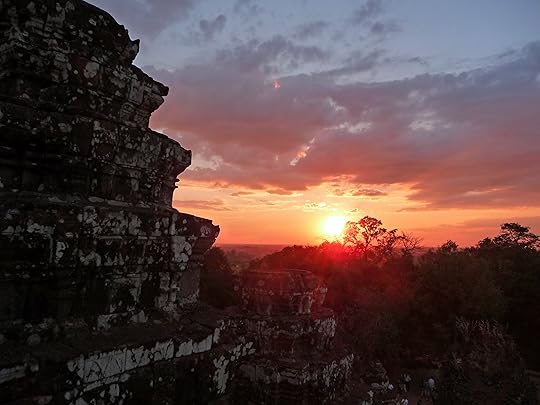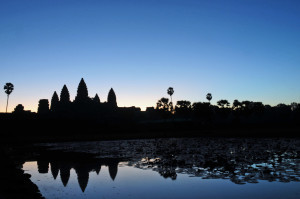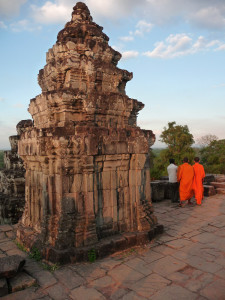Keys to the Kingdom

Is there anything more intriguing than a “lost city” rediscovered? I doubt that I am the only one that loves pondering a good mystery like the fate of the Mayans or the original purpose of Machu Picchu. Perhaps it’s only to compare the downfall of former great civilizations to our own existence here on planet Earth and what lies in store for our future, but I can’t turn down a good documentary on the subject. If you ask my husband, he’ll tell you they often lead to a bout of intense travel planning and are best avoided. That’s probably why he fled the room when a television program about the Kingdom of Angkor recently began.
The trip we took to Cambodia and Laos was an all-time favorite, especially the time we spent in Siem Reap, the gateway to Angkor Wat, Angkor Thom, and the Kingdom of Angkor. Though this capital of the northwest Cambodian province houses, feeds, and entertains more than a million tourists per year, it maintains a “village” feel. There are numerous resorts to pick from and plenty of ways to visit the thousands of incredible temples being preserved here, but the dusty streets and warm locals welcome you as a friend. A friend with money, perhaps, but a friend nonetheless. Sadly, there were also more street children here than other Asian cities—many more—but their beautiful faces would depart upon hearing the word “no.” Knowing a few dollars would make a very big difference to a family, I often wanted to say “yes” to a package of postcards I didn’t need, but we were warned ahead of time that if the children make much money this way, they believe they don’t have to go to school. I’d rather a disappointed face for a few minutes over a lifetime of it, so I heeded the warning.
Friends who had made the trip before us reported being “templed-out” after a few days, so we tried not to rush through these works of art without appreciating their unique details. Another bit of good advice we received was to hire a guide for our days in Angkor. That and an air-conditioned van made the excursions much more pleasant. The fierce sunlight and excessive humidity take their toll quickly and the ability to chill out between stops helped us revive enough to listen to the tales spun by our guide Bona. The master stroke behind hiring a guide, however, was his knowledge of the area. He knew when busloads of tourists would arrive at a particular spot and would whisk us away to another temple for a more secluded visit. A few dollars a day have never been so well spent.
In fact, the crowds were the only downside to the entire visit. We arrived a few days before Christmas which is prime-time for global travel and our fellow adventurers were rarely far behind. We woke up at 4:30am to make the trip to the ruins to see the sun rise into a purple-pink sky over the miraculous reflection pool in front of Angkor Wat and Bona made sure we arrived before the masses. My husband set up his tripod a few feet back from the water’s edge and as we waited for sunrise, we watched every available inch of grass become covered with other tourists. My normally mellow hubby was fuming when a Korean family moved in between us and the water—blocking his camera shot entirely. By the time we tried to move, it was a free-for-all. Women shouted to husbands. Boyfriends unpacked enormous camera lenses. The line of tents selling food and trinkets behind us completed the circus-like feel. But the best thing? You can’t tell any of this from the beautiful photos we walked away with.
Similarly, we climbed Phnom Bakheng, a mountain-like active Buddhist temple, late one afternoon to watch the sun set over Angkor Wat. We were quite early, but the masses were ahead of us this time. By the time we reached the top, it was difficult to find a few feet of stone to perch ourselves and our cameras. Thankfully, the vibe here was different from the dawn event and people maintained a quiet reverence due to the presence of the monks. Watching the sky turn orange, just like the robes they wore, was a religious experience—one I will never forget.
There are far too many temples to mention here and your guide or guidebook (in my case, both!) will help you tremendously in determining which ones to visit. Want to see where Angelina Jolie stood filming Tomb Raider? Right this way! Interested in the Terrace of the Leper King? Jump in! One thing you will not be in Siem Reap is bored. Opportunities to explore are endless and there is always someone nearby to show you the way. For a quick read, you can learn about the major attractions here.
This precious collection of artifacts and temples dating from the 8th century is a marvel of mankind’s ability to create. Visiting the various collections of temples allows you to see the development of a civilization and track its advancement. (A comprehensive list of temples and dates can be found here). They become more intricate and sophisticated as the centuries pass—but there is an abrupt end around the year 1431 when the Angkor Civilization (also known as the Khmer Empire) collapsed. The story of the empire, written in detailed Sanskrit, can be traced throughout the kingdom, but in the middle of the fifteenth century, the trail disappears.
Since the “re-discovery” of Angkor by a French naturalist in the 1800’s scientists have been scratching their heads over the cause of their disappearance. One of my beloved documentaries only recently delivered the most plausible theory to date. Angkor continued to develop over time and at its peak, it comprised most of Cambodia, central Thailand, southern Viet Nam, and even areas of Laos. When the early civilization developed, the climate delivered the best possible conditions. Later, in the 13th century, there is evidence of severe drought. The Khmer developed an effective irrigation system to combat the problem, but the drought conditions persisted. By examining tree rings in the area, scientists know that relief came after several years, but drought returned and worsened the next century.
Finally, water did begin to fall from the sky to the parched land and people below. In fact, it began and never stopped. The years of drought were followed by massive monsoon rains which, due to the extensive irrigation system they had built, destroyed the city. Warring factions in the area and political instability are thought to have contributed to the downfall of this majestic empire, but it appears that climate change was their Achilles’ heel.
So, to review, a highly-sophisticated civilization which was at the time one of the most advanced in the world was brought down by its own ability to solve potential crises and by extreme changes in climate that they could not control. Does this story sound frighteningly familiar to anyone? It certainly does to me.
The post Keys to the Kingdom appeared first on Worldwise Publications.




